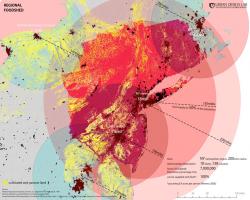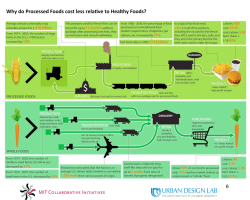National Integrated Regional Food System
Overview
Understanding that a national food system based on access, affordabiility and quality has the potential to dramatically improve population health and thereby decrease healthcare costs, this project will use the unique design methodology proven in the Collaborative’s Stroke Pathways and Childhood Obesity projects to develop a broad national framework for refocusing the Food System.
We believe that the development of a system of integrated Regional Foodsheds—geographic areas from which a large percentage of a region’s food could be sourced – is a model which can work.
Our goal in this project is to provide evidence supporting the value of moving to a food system based on integrated regional foodsheds in terms of health, sustainability and economic development while developing an action plan for making this dramatic transition on a national level.
Background
Beginning in September 2007, the Urban Design Lab at the Earth Institute at Columbia University and MIT Collaborative Initiatives embarked on a system-based effort to address the challenge of the Childhood Obesity epidemic. The final outcome - food and health are intricately linked. In order to support programs addressing childhood obesity and chronic disease prevention, there must be a national foodsystem based on access, affordability, quality and health. Access to an affordable, healthy diet is essential to a national health and wellness strategy.
There are many barriers to transforming the current foodsystem into one that prioritizes health, while also promoting ecological sustainability and economic development. The existing food production, processing, transportation, and retail infrastructure is based on a model that emphasizes maximizing quantity of food, not quality. In order to change this, entrenched economic and political interests will have to be overcome, and an entirely new food infrastructure will have to be developed.
Strategy
NM5, November 29, 2011 | NIRF Presentation
The foodshed concept is an answer to this challenge. The foodshed, based on the idea of a watershed, is a geographic area from which a large percentage of a region’s food could be sourced. A national foodsystem built around foodsheds would:
- Increase access by increasing regional supply and retail outlets;
- Increase affordability by dramatically decreasing production, processing and transportation costs;
- Improve quality by decreasing the distance from farm to plate, thereby lessening the need for long-shelf-life processed foods.
A number of regions around the nation are in the process of developing local and regional foodshed models. We believe that our greatest opportunity lies in coordinating and enhancing these efforts through the development of a national framework of integrated regional foodsystems.
Foodsystem reform is critically relevant to issues of public health, the environment, energy, and economic stability. Developing a national framework for change will involve input from and cooperation among industry, agriculture, non-profit, academic, government and health partners.
Press Release
NEWS RELEASE MIT Collaborative Initiatives (MIT-CI) and the Urban Design Lab at the Earth Institute, Columbia University (UDL) Announce Completion of a Three-Year Look at Nation’s Obesity Crisis: National Food System Infrastructure Identified as a Primary Culprit (PDF)




